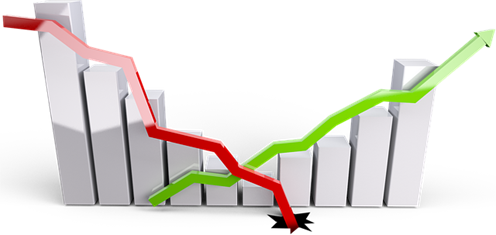You might have heard that a good, profitable, robust trading strategy which has tended to work well with Forex, commodities, and stocks is a volatility breakout trading strategy. But what exactly is this kind of strategy, how does it work, and why is it attractive to traders who want to make money?

The Breakout Part
Let’s look at the breakout part of the strategy first. Most traders are familiar with the concept of breakouts as they have been at the center of trading strategies for an extremely long time. One famous example is the Turtle Trading Strategy used by famed commodities trader Richard Dennis in the early 1980s. Breakouts even have their own classic technical indicator in the form of the Donchian Channel, created in the 1970s by the American commodities trader Richard Donchian. In the 1970s new computer technology made it easier for early programmers to discover that the best trades tended to happen when prices were making new high or low prices they had not made for a long period of time. The concept is very easy to understand and apply. For example, you might define a long breakout as when the price makes its highest price in 50 days, and a short breakout as when the price makes its lowest price in 50 days. Breakouts can be defined in more complicated ways than this, of course. Some traders might define a 50-day breakout as the day’s closing price being higher or lower than any closing price seen over the past 50 days, arguing that this prevents excessive “false breakouts” by making sure the price must spend some time exceeding the previous price extremes before a breakout is deemed to be technically triggered.
If you find this exciting, you might go and test some historical price data to see what happened over the next couple of days when the price made its highest or lowest close over, say, 50 days. If you do, based upon the three major Forex currency pairs since 2001, this is what you will find:
| Currency Pair | Total Trades | Day 1 | Day 2 | ||||
| Edge Ratio | Average Pips at Close | Win % at Close | Edge Ratio | Average Pips at Close | Win % at Close | ||
| EUR/USD | 738 | 1.06 | 2 | 50.27% | 1.09 | 5 | 52.85% |
| GBP/USD | 699 | 1.19 | 4 | 49.64% | 1.16 | 7 | 52.79% |
| USD/JPY | 696 | 1.15 | 0 | 46.41% | 1.13 | 3 | 51.01% |
At first sight, this looks good. If you had just waited for the end of a trading day and opened a trade in the direction of the 50-day breakout and closed the trade two days later, you would have won about 52% of the trades and made approximately 5 pips profit on average per trade. The edge ratio is calculated as the ratio between the total pips travelled in profit and the total pips travelled in loss, so the higher the edge ratio, the better. The true numbers here are a little lower than shown as spreads were not included in those calculations. The average pip and win percentage data are calculated based on a 1 pip spread. Overnight financing fees (swap rates) are common but are not included in these statistics. Yet, there would have been challenges in following this as a rigid strategy even though it was profitable.
The first problem is that returns were not evenly distributed. There were long losing streaks. The second problem is that most returns or losses were small, with a few huge winners and losers. These two problems are only fully understandable when you consider what they do to your account size when you risk the same percentage of your equity on each trade: long losing streaks and huge individual losing trades can wipe out weeks or months of small but steady gains.
We can illustrate this by saying it is worth looking at what happens to a $1,000 account risking 1% of equity per trade in a series of 10 trades with the same overall result, depending upon how the results are distributed.
We need to see if we can improve on our methodology to improve the statistics shown on historic 50-day breakout trades on the three major Forex currency pairs.
One answer could be to take only the daily breakouts where the closing price is within the top quarter of the day’s range. Logically, this would tend to show strongly positive momentum at the time the trade is entered. Let’s see how the numbers look when we add this filter:
| Currency Pair | Total Trades | Day 1 | Day 2 | ||||
| Edge Ratio | Average Pips at Close | Win % at Close | Edge Ratio | Average Pips at Close | Win % at Close | ||
| EUR/USD | 478 | 1.20 | 7 | 54.39% | 1.24 | 12 | 56.07% |
| GBP/USD | 415 | 1.19 | 4 | 48.67% | 1.20 | 11 | 53.49% |
| USD/JPY | 413 | 1.08 | -2 | 43.34% | 1.07 | 1 | 48.91% |
These results were a little better, although the total number of trades fell by about one third. The average trade gives about 8 pips of profit instead of 5, but the overall win percentage hardly changes – it only increases by a tiny amount. Is there another way we could raise the overall win percentage? Luckily, there is.
The Volatility Part
There is a reason why volatility breakouts are called by this name: because they are breakouts which happen with high volatility. For example, suppose stock A typically moves by a value of about $1 per day and has never traded above $50 per stock. Then one day the price closes at either $51 or $54. Which of these two examples do you think would be the better long trade entry? All other variables being equal, the $54 close would be more likely to give a winning trade entry – because it took place on high (above average) volatility. There are two major reasons why. Firstly, volatility clusters – if it is high today, it is likely to be high tomorrow, so if the breakout move continues, it is more likely to go relatively far. Secondly, the further above a resistance level the price can remain for a longer period, the more probable it is that the move would continue.
What happens if we apply this logic to our back test of the three major currency pairs since 2001? The first thing we need is an indicator to measure relative volatility. This is best done by using an Average True Range indicator with a look-back period of 15 days, which is short enough to be sufficiently adaptive while being long enough to be properly representative of average volatility. We use the same filters as before: a close at a 50-day high or low, and within the top or bottom quarter of the day’s range, and we add the volatility filter that the day’s total range must be at least 150% of the value of the ATR (15) indicator at the close. We get considerably fewer trades, but just look at these back-test results:
| Currency Pair | Total Trades | Day 1 | Day 2 | ||||
| Edge Ratio | Average Pips at Close | Win % at Close | Edge Ratio | Average Pips at Close | Win % at Close | ||
| EUR/USD | 118 | 1.66 | 20 | 64.41% | 1.75 | 28 | 66.95% |
| GBP/USD | 124 | 1.62 | 21 | 55.65% | 1.72 | 38 | 58.87% |
| USD/JPY | 99 | 1.10 | 1 | 43.43% | 1.21 | 10 | 54.55% |
These results are much better than the earlier back-tests. Here, the average trade gave about 27 pips of profit instead of 8, and the overall win percentage rose significantly as well, to approximately 59% from 53%. Overall, it was a much better positive expectancy to use to grow an account. Now you can see why trading the stronger volatility breakouts with discipline and patience can help to grow your trading account. You don’t have to chase the breakouts as they happen, you can wait for the end of the day to see if a breakout holds up. Being early is bigger problem than being late! Please note how profitable this strategy was historically by simply applying a time-based exit strategy. I have not gone into detail on stop losses here, because provided any method used to calculate stops was applied consistently, this data shows it should still have been profitable.
Lower Time Frames
By now, you might be thinking about trying this approach with shorter time frames below daily, for example H4 or even H1. Some analysts say that the market is fractal, and that approaches which work on higher time frames should tend to work just as well on lower time frames. This is not true. If we had applied the same criteria over the same time period to the H4 time frame, these were the comparable results:
| Currency Pair | Total Trades | Hour 4 | Hour 8 | ||||
| Edge Ratio | Average Pips at Close | Win % at Close | Edge Ratio | Average Pips at Close | Win % at Close | ||
| EUR/USD | 931 | 1.22 | 1 | 49.30% | 1.23 | 3 | 51.56% |
| GBP/USD | 980 | 1.16 | 1 | 46.84% | 1.18 | 2 | 51.33% |
| USD/JPY | 801 | 1.23 | 1 | 46.07% | 1.24 | 1 | 46.94% |
These results were obviously far worse, even though we would expect the average pips of profit per trade to be much smaller. You can see that, while it is still profitable, the edge ratios and win percentages were on average much smaller than when applied to the daily time frame.
Conclusion
What has been shown here is not a complete strategy, but it is a clear and robust path to trading profitably with technical analysis. It can be made better by letting winners run (the data uses a maximum 2 days before a time-based exit), cutting losers short, and applying intelligent hard stop loss orders.

We hope you found our site useful and we look forward to helping you again soon!